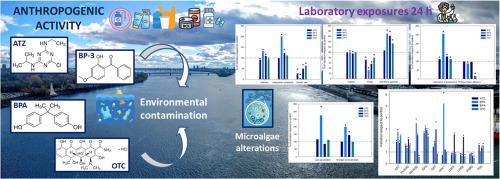Ecotoxicology and Environmental Safety ( IF 6.2 ) Pub Date : 2020-11-17 , DOI: 10.1016/j.ecoenv.2020.111646 Laura Míguez , Marta Esperanza , Marta Seoane , Ángeles Cid

|
Contamination of aquatic ecosystems linked to anthropogenic activity is currently a major concern; therefore, ecotoxicological studies are needed to assess its effect on organisms. The main objective of this study was to investigate the effects of different pollutants on microalgae in search of sensitive biomarkers that can promote a common cytotoxic response regardless of the contaminant. Cultures of the freshwater microalga Chlamydomonas reinhardtii were exposed for 24 h to four chemicals, three emerging pollutants (benzophenone-3, bisphenol A and oxytetracycline) and one priority substance (atrazine). A cytometric panel was carried out to assess toxicity biomarkers including cellular growth, inherent cell properties, viability, vitality, cytoplasmic membrane potential and ROS levels. Lipid peroxidation, photosynthetic efficiency and transcriptional responses of photosynthesis- and oxidative stress-related genes using RT-qPCR were also studied. Some toxicity responses showed a similar pattern; a decrease in growth rate, vitality and photosynthetic efficiency and an increase in autofluorescence and in the number of cells with depolarised cytoplasmic membrane and were found for all chemicals tested. However, ATZ and OTC provoked a decrease in cell size, whereas BP-3 and BPA caused an increase in cell size, intracellular complexity and ROS levels and a decrease in cell viability. Assayed pollutants generally promoted an overexpression of genes related to cellular antioxidant defence system and a subexpression of photosynthesis-related genes. In addition to the traditional growth endpoint, cell vitality, autofluorescence and gene expression of catalase, glutathione peroxidase and Fe-superoxide dismutase were significantly affected for all chemicals tested, showing a common cytotoxic response. Among the tested substances, BP-3 provoked the strongest cytotoxic alterations on this microalga, pointing out that some emerging contaminants could be more harmful to organisms than priority pollutants.
中文翻译:

对暴露于新兴污染物和优先污染物的微藻莱茵衣藻的细胞毒性生物标记物的评估
目前,与人为活动有关的水生生态系统受到污染是一个主要问题;因此,需要进行生态毒理学研究以评估其对生物的影响。这项研究的主要目的是研究不同污染物对微藻的影响,以寻找可以促进常见的细胞毒性反应而不管污染物如何敏感的生物标志物。淡水微藻莱茵衣藻的培养暴露于四种化学物质,三种新兴污染物(二苯甲酮-3,双酚A和土霉素)和一种优先物质(阿特拉津)24小时。进行了细胞计数小组评估毒性生物标志物,包括细胞生长,固有细胞特性,生存力,活力,细胞质膜电位和ROS水平。还使用RT-qPCR研究了脂质过氧化,光合作用效率以及光合作用和氧化应激相关基因的转录反应。一些毒性反应显示出相似的模式。对于所有测试的化学品,发现生长速率,活力和光合作用效率降低,自发荧光增加,细胞质去极化的细胞数量增加。但是,ATZ和OTC引起了像元大小的减小,而BP-3和BPA导致细胞大小增加,细胞内复杂性和ROS水平升高,并使细胞活力降低。分析的污染物通常促进与细胞抗氧化剂防御系统相关的基因的过表达和与光合作用相关的基因的亚表达。除传统的生长终点外,所有测试的化学品均显着影响过氧化氢酶,谷胱甘肽过氧化物酶和铁超氧化物歧化酶的细胞活力,自发荧光和基因表达,显示出常见的细胞毒性反应。在测试的物质中,BP-3引起了该微藻最强的细胞毒性改变,指出某些新兴污染物比优先污染物对生物的危害更大。分析的污染物通常促进与细胞抗氧化剂防御系统相关的基因的过表达和与光合作用相关的基因的亚表达。除传统的生长终点外,所有测试的化学品均显着影响过氧化氢酶,谷胱甘肽过氧化物酶和铁超氧化物歧化酶的细胞活力,自发荧光和基因表达,显示出常见的细胞毒性反应。在测试的物质中,BP-3引起了该微藻最强的细胞毒性变化,指出某些新兴污染物比优先污染物对生物的危害更大。分析的污染物通常促进与细胞抗氧化剂防御系统相关的基因的过表达和与光合作用相关的基因的亚表达。除传统的生长终点外,所有测试的化学品均显着影响过氧化氢酶,谷胱甘肽过氧化物酶和铁超氧化物歧化酶的细胞活力,自发荧光和基因表达,显示出常见的细胞毒性反应。在测试的物质中,BP-3引起了该微藻最强的细胞毒性改变,指出某些新兴污染物比优先污染物对生物的危害更大。过氧化氢酶,谷胱甘肽过氧化物酶和铁超氧化物歧化酶的自发荧光和基因表达对于所有测试的化学品均受到显着影响,显示出常见的细胞毒性反应。在测试的物质中,BP-3引起了该微藻最强的细胞毒性变化,指出某些新兴污染物比优先污染物对生物的危害更大。过氧化氢酶,谷胱甘肽过氧化物酶和铁超氧化物歧化酶的自发荧光和基因表达对于所有测试的化学品均受到显着影响,显示出常见的细胞毒性反应。在测试的物质中,BP-3引起了该微藻最强的细胞毒性改变,指出某些新兴污染物比优先污染物对生物的危害更大。











































 京公网安备 11010802027423号
京公网安备 11010802027423号